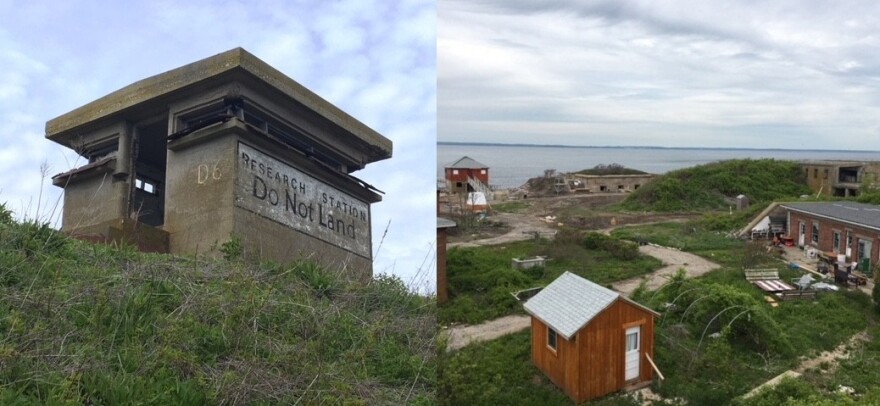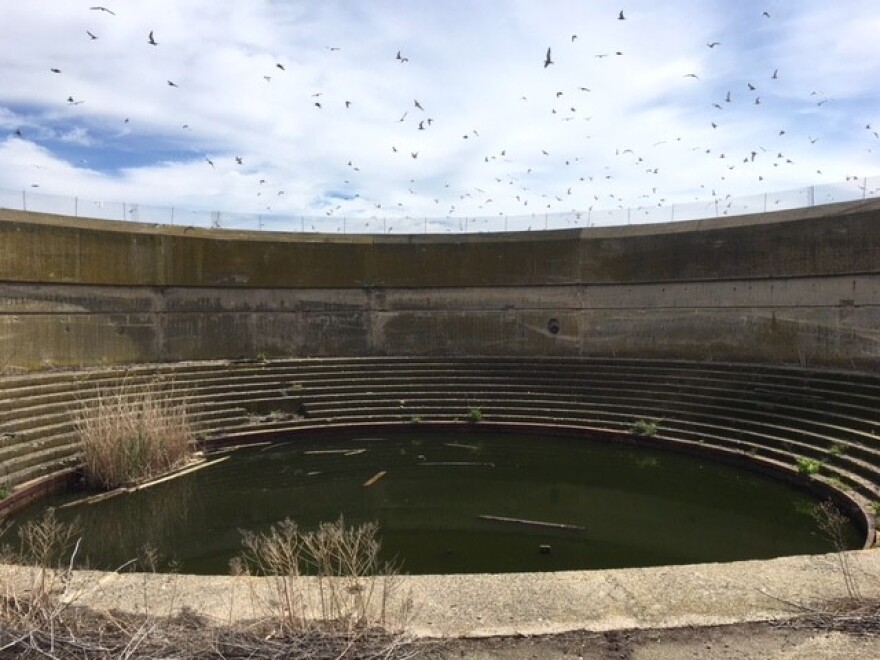There’s a tiny island off the coast of Connecticut. Its residents are more than ten thousand little white seabirds called terns. They have long orange beaks and sometimes ominous black tufts on their heads. There might be more terns on this island than anywhere on earth. And for fifty years, one woman has served as steward and caretaker.
I’m on a boat, on the way to Great Gull Island, in the middle of Long Island Sound. The boat pulls up to the pier, and the first thing I notice are the birds. They circle in a frenetic – almost swarm – over the beach, and they’re loud.
An elderly woman waits for me on the pier. She leans on a cane, but her eyes are bright. This is Helen Hays.

“We’re going down to see the first egg in a few seconds. It’s a very exciting event, the first egg.”
The first freshly-laid tern egg of the season. Helen and her high school or college-age volunteers walk the island every day in the spring and look for eggs. One of the volunteers found the egg yesterday on the beach.
“Now he’s afraid it won’t be there, but it will be there.”
This island is covered in thousands of eggs, and volunteers – up to 30 of them every spring during breeding season. The island is owned by Helen’s employer, the American Museum of Natural History. But she doesn’t see it that way.
“Mainly belongs to the terns,” she says.
Back in the ‘60s, when Helen first came to Gull Island, there were no humans here. She was a college graduate working for the museum. She’d always loved birds, and knew she didn’t want a desk job.
“My parents kept asking me what I was going to do in life, and I said field work.”
Helen was in the right place at the right time. The U.S. Army had just sold the abandoned 17-acre island to the natural history museum. It had been the site of Fort Michie since the late 1800s. And during World War II it housed the most powerful weapon in the U.S. arsenal. The M1919 machine gun was so big it needed it to be mounted on a turret the size of a swimming pool.
“They can do plenty of damage. An outstanding case where it’s better to give than to receive.”
More advanced weapons made guns like the M1919 obsolete after World War II. The army closed the base in 1948. And then, the island’s former citizenry sensed the new peace and quiet and moved back in.
They began to nest in the abandoned guard towers and big concrete bunkers of Fort Michie. And that’s where Helen Hays found them when she volunteered for research on the island in the 1960s.

“It seemed to me we could see how many birds were here, nobody knew. And I thought that would be really fun.”
Helen got a few interns together and got to work counting the birds. And they also made the island more habitable for the occasional human population.
“The buildings were kind of torn apart. But not so that you couldn’t repair them a little bit. So that’s what we did.”
The volunteers spent weeks at a time on the island. But Helen stayed nearly half the year. She kept an eye on their breeding habits, tagged them to find out where they went, protected them from predators, and their numbers increased almost right away.
“I didn’t have any doubt they’d increase...I never expected to have such an increase as we noticed.”
And that increase was almost tenfold to over ten thousand birds. Great Gull Island now has the highest tern population in the Western Hemisphere. Maybe the world.

But I’m not sure the terns really appreciate what the volunteers have done for them. For one thing, you have to protect yourself when you’re out here. One of the volunteers, Ruby, hands me a hat garnished with camouflaged flowers.
“The birds may dive bomb your head, so if you want some flowers to put on top, they’ll attack the flowers instead.”

Despite the constant fear of birds drilling a hole in your head, Helen and her helpers have carved out a nice little niche here over the years. Now there’s dorm-style bunks – a little sparse, I guess, but functional – and there’s a shack with a cute kitchen and a reading nook for volunteers – like Owen Friesen. He’s a high school student and his mom also volunteered back in the ’80s.
“She had told me about the mobs of terns. Even back then, they wore the straw hats, they would dive bomb.”
That was a little scary for Owen. But he feels like you can’t really blame the birds for assaulting the aliens on the island.
“They can be vicious, but this was their rock before we came here. I always feel like a guest in this place.”
So does Helen Hays. And she’s not too worried what will happen to the birds when she can no longer watch out for them. She’s helped them a lot over five decades. But these birds are pretty tough. Whether they’re avoiding predators or hurricanes.
“They always seem to survive it, whatever it is. They face into the wind and stay there, that’s it.”
Davis Dunavin is the host of the podcast Off the Path, where he explores unusual, fascinating stories from New York to Boston. Subscribe to Off the Path on Apple Podcasts, Google Play or wherever you get your podcasts. Got an idea for an episode? Email us!





